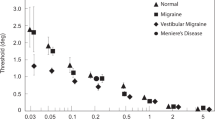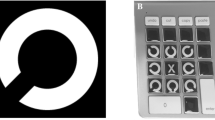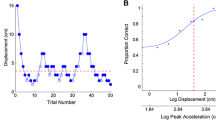Abstract
Vestibular migraine (VM), defined as vestibular symptoms caused by migraine mechanisms, is very common but poorly understood. Because dizziness is often provoked in VM patients when the semicircular canals and otolith organs are stimulated concurrently (e.g., tilting the head relative to gravity), we measured tilt perception and eye movements in patients with VM and in migraine and normal control subjects during fixed-radius centrifugation, a paradigm that simultaneously modulates afferent signals from the semicircular canals and otoliths organs. Twenty-four patients (8 in each category) were tested with a motion paradigm that generated an inter-aural centrifugal force of 0.36 G, resulting in a 20° tilt of the gravito-inertial force in the roll plane. We found that percepts of roll tilt developed slower in VM patients than in the two control groups, but that eye movement responses, including the shift in the eye’s rotational axis, were equivalent in all three groups. These results demonstrate a change in vestibular perception in VM that is unaccompanied by changes in vestibular-mediated eye movements and suggest that either the brain’s integration of canal and otolith signals or the dynamics of otolith responses are aberrant in patients with VM.




Similar content being viewed by others
References
Angelaki DE, McHenry MQ, Dickman JD, Newlands SD, Hess BJ (1999) Computation of inertial motion: neural strategies to resolve ambiguous otolith information. J Neurosci 19:316–327
Bremova T, Caushaj A, Ertl M, Strobl R, Bottcher N, Strupp M, MacNeilage PR (2016) Comparison of linear motion perception thresholds in vestibular migraine and Meniere’s disease. Eur Arch Otorhinolaryngol epub ahead of print
Casini AP, Sellari-Franceschini S, Napolitano A, Muscatello L, Dallan I (2009) Otoneurologic dysfunctions in migraine patients with and without vertigo. Otol Neurotol 30:961–967
Cohen B, Wearne S, Dai M, Raphan T (1999) Spatial orientation of the angular vestibulo-ocular reflex. J Vestib Res 9:163–172
Cousins S, Kaski D, Cutfield N, Seemungal B, Golding JF, Gresty M, Glasauer S, Bronstein AM (2013) Vestibular perception following acute unilateral vestibular lesions. PLOSone 8, e61862
Cullen KE (2011) The neural encoding of self-motion. Curr Opin Neurobiol 21:587–595
Engelken EJ, Stevens KW (1990) A new approach to the analysis of nystagmus: an application for order-statistic filters. Aviat Space Environ Med 61:859–864
Furman JM, Sparto PJ, Soso M, Marcus D (2005) Vestibular function in migraine-related dizziness: a pilot study. J Vestib Res 5:327–332
Furman JM, Marcus DA, Balaban CD (2013) Vestibular migraine: clinical aspects and pathophysiology. Lancet Neurol 12:706–715
Golding JF (1998) Motion sickness susceptibility questionnaire revised and its relationship to other forms of sickness. Brain Res Bull 47:507–516
Headache Classification Subcommittee of the International Headache Society (2004) The International Classification of Headache Disorders. Cephalalgia 24:60–63
Kayan A, Hood JD (1984) Neuro-otological manifestations of migraine. Brain 107:1123–1142
Lempert T, Olesen J, Furman J, Waterson J, Seemungal B, Carey J, Biddorff A, Versino M, Evers S, Newman-Toker D (2012) Vestibular migraine: diagnostic criteria. J Vestib Res 22:167–172
Lewis RF, Haburcakova C, Merfeld DM (2008) Roll tilt psychophysics in rhesus monkeys during vestibular and visual stimulation. J Neurophysiol 100:140–153
Lewis RF, Priesol A, Nicoucar K, Lim K, Merfeld DM (2011a) Abnormal motion perception in vestibular migraine. Laryngoscope 121:1124–1125
Lewis RF, Priesol A, Nicoucar K, Lim K, Merfeld DM (2011b) Dynamic tilt thresholds are reduced in vestibular migraine. J Vestib Res 21:323–330
Meng H, May PJ, Dickman JD, Angelaki DE (2007) Vestibular signals in primate thalamus: properties and origins. J Neurosci 27:13590–13602
Merfeld DM, Zupan LH, Gifford CA (2001) Neural processing of gravito-inertial cues in humans. II. Influence of semicircular canals during eccentric rotation. J Neurophysiol 85:1648–1660
Merfeld DM, Park S, Gianna-Poulin C, Black FO, Wood S (2005) Vestibular perception and action employ qualitatively different mechanisms. I. Frequency response of VOR and perceptual responses during translation and tilt. J Neurophysiol 94:186–198
Neuhauser H, Leopold D, vonBrevern M, Arnold G, Lempert T (2001) The interrelations of migraine, vertigo, and migrainous vertigo. Neurology 56:436–441
Neuhauser HK, Radtke A, von Breven M, Feldmann M, Lezius F, Ziese LT (2006) Migrainous vertigo: prevelance and impact on quality of life. Neurology 67:1028–1033
Park S, Gianna-Poulin C, Black FO, Woods S, Merfeld DM (2006) Roll rotation cues influence roll tilt perception assayed using a somatosensory technique. J Neurophysiol 96:486–489
Russo A, Marcelli V, Esposito F, Corvino V, Marcuccio L, Giannone A, Conforti R, Marciano E, Tedeschi G, Tessitore A (2014) Abnormal thalamic function in patients with vestibular migraine. Neurology 82:2120–2126
Shaikh AC, Palla A, Marti S, Olasagasti I, Optican LM, Zee DS, Straumann D (2013) Role of cerebellum in motion perception and vestibulo-ocular reflex—similarities and disparities. Cerebellum 12:97–107
Zaleski A, Bogle J, Starling A, Zapala DA, Davis L, Wester M, Cevette M (2015) Vestibular evoked myogenic potentials in patients with vestibular migraine. Otol Neurotol 36:295–302
Acknowledgments
We thank Dan Merfeld for the comments on the study and Dave Balkwill for technical assistance. This study is supported by the National Institutes of Health grant DC012528 to RFL.
Author information
Authors and Affiliations
Corresponding author
Rights and permissions
About this article
Cite this article
Wang, J., Lewis, R.F. Abnormal Tilt Perception During Centrifugation in Patients with Vestibular Migraine. JARO 17, 253–258 (2016). https://doi.org/10.1007/s10162-016-0559-7
Received:
Accepted:
Published:
Issue Date:
DOI: https://doi.org/10.1007/s10162-016-0559-7




